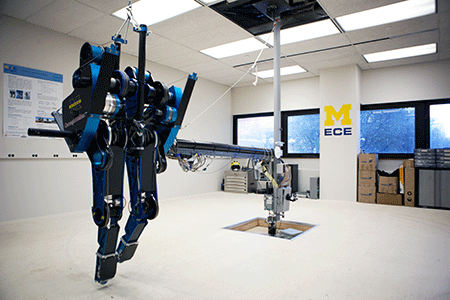From the moment it arrived at the University of Michigan in Ann Arbor as a set of unassembled carbon and fiber parts, Jessy Grizzle sought to get MABEL running.
Standing nearly six feet tall, MABEL (Michigan Anthropomorphic Biped with Electric Legs), is a 150-pound, two-legged machine designed to be the next step in the evolution of robotics. While Honda’s ASIMO robot moves at a flat pace, Grizzle wanted to see if bipedal robotic movements could be programmed to emulate some of the dexterity that humans enjoy.
“You can get results that can be applied to help human prosthesis,” says Grizzle, a professor in the Department of Electrical Engineering and Computer Sciences at U-M’s College of Engineering. “You’re also going to get machines to (one day) go where humans won’t go.”
To bring bipedal robotic systems to the forefront, Grizzle and a select group of Ph.D. students tapped funding from the National Science Institute and the Defense Advanced Research Projects Agency to develop an intricate feedback control system comprised of algorithms that would allow MABEL to mimic walking with a human gait — a feat that has eluded robotic engineers.
“We wanted to compile a mathematical theory of bipedal functions for higher performance,” Grizzle says.
Already, MABEL has been programmed to walk forward and backward. It also can run a nine-minute mile, traverse irregular ground, and reach a top speed of 6.8 mph. The machine is believed to be the world’s fastest bipedal robot with knees.
Apart from reaching numerous milestones, MABEL was designed to assist in the development of exoskeletons that someday may help wheelchair-bound individuals walk, and to propel the introduction of virtual machines that can be used to aid search and rescue missions.
Rather than rely on a camera to detect what’s in its path, MABEL uses contact switches on the bottom of its feet to feed sensory information into an onboard computer that houses mathematical formulas.
Now that MABEL has proven its mettle, work has started on a next-generation robot called ATRIAS (Assume The Robot Is A Sphere). Grizzle predicts the new robot will be more versatile and better equipped for experimentation than the retiring MABEL, which had to be secured to a boom in order to keep its hips in place.
“ATRIAS will be untethered, with all power and control computations on board,” Grizzle says. “We expect it will be faster than MABEL, and more energy-efficient.” db












